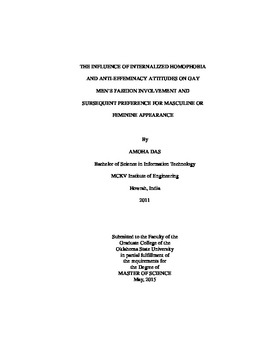| dc.contributor.advisor | Stroescu, Mary R | |
| dc.contributor.author | Das, Amoha | |
| dc.date.accessioned | 2016-09-29T18:33:02Z | |
| dc.date.available | 2016-09-29T18:33:02Z | |
| dc.date.issued | 2015-05-01 | |
| dc.identifier.uri | https://hdl.handle.net/11244/45156 | |
| dc.description.abstract | Studies have examined gay men�s fashion involvement, however few have measured this phenomenon in the context of negative prejudices that exist within the gay community itself. More specifically, there is a gap in the literature related to examining the influence of internalized homophobia and anti-effeminacy attitudes on gay men�s fashion involvement. There is also a need to explore gay men�s current definitions of masculinity and femininity in relation to fashion and clothing. Applying the framework of Social Identity Theory (SIT), the purpose of this mixed method study was twofold. First, it measured the influence of internalized homophobia and anti-effeminacy attitudes (among gay men) on gay men�s fashion involvement on one hand and their preferences for either masculine or feminine clothing on the other. Secondly, this study explored gay men�s definitions of masculine or feminine appearance in the context of clothing fashion. Additionally the study explored the relationship between fashion involvement in gay men and subsequent preference for masculine or feminine appearance. Data analysis revealed that gay men who were fashion conscious and fashion innovators displayed lower levels of internalized homophobia in social situations. In addition, gay men who had higher anti-effeminacy attitudes showed a preference for masculine appearance in the context of clothing fashions and gay men who were fashion innovative communicators, showed preference for a feminine or less masculine appearance. Overall participants described their dress preference as masculine. Implications of this study include the recognition of a previously neglected market potential, by creating less masculine clothing lines or less gender-specific merchandising techniques to cater to the needs of highly fashion involved gay men who have a potential for higher average spending on clothing. | |
| dc.format | application/pdf | |
| dc.language | en_US | |
| dc.rights | Copyright is held by the author who has granted the Oklahoma State University Library the non-exclusive right to share this material in its institutional repository. Contact Digital Library Services at lib-dls@okstate.edu or 405-744-9161 for the permission policy on the use, reproduction or distribution of this material. | |
| dc.title | Influence of Internalized Homophobia and Anti-effeminacy Attitudes on Gay Men�s Fashion Involvement and Subsequent Preference for Masculine or Feminine Appearance | |
| dc.type | text | |
| dc.contributor.committeeMember | Clare, Greg | |
| dc.contributor.committeeMember | Swinney, Jane | |
| dc.contributor.committeeMember | Mclaughlin, Heather | |
| osu.filename | Das_okstate_0664M_13977.pdf | |
| osu.accesstype | Open Access | |
| dc.description.department | Design, Housing, & Merchandising | |
| dc.type.genre | Thesis | |
